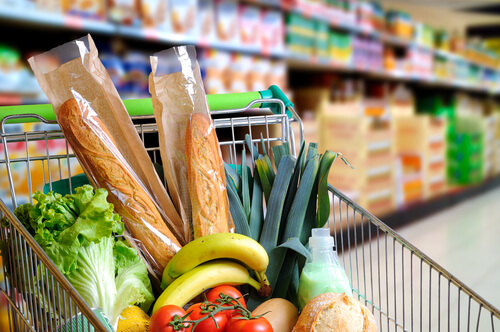what is the average time single women go to the supermarket
 Fact Checked
Fact Checked
Buying groceries is one of our biggest living expenses after housing costs, so it makes 'cents' Aussies wait to reduce their grocery bills whenever possible. For that, information technology's important to know exactly what nosotros're spending at the supermarket each shop, in club to then adjust our budgets and buying habits accordingly.
That's why we take compiled this guide on average grocery bills in Commonwealth of australia. Nosotros've included boilerplate grocery costs by country, household size, income, age group, and supermarket, plus listed some budgeting tips to reduce your grocery bill.
Average grocery nib in Australia
Aussie households spend on boilerplate $153 per week on groceries, according to Canstar Blueish'southward latest survey of supermarket shoppers. This equates to about $612 a month or $seven,344 a year. The average weekly spend for larger households of five or more people is roughly $255, with the majority of this spent on staple or everyday food items.
Here's what well-nigh Aussies buy in their weekly food, every bit found in our survey:
- Bakery items (i.e. bread): 63%
- Pantry items (i.e. rice, pasta, cooking oil, etc): 62%
- Fruit/vegetables: 58%
- Dairy/eggs: 58%
- Frozen foods: 56%
- Meat/seafood/deli items: 49%
Average grocery neb by country
This table shows the boilerplate weekly grocery bill across Australian states, based on a Canstar Blue survey of more than than ii,600 households (of all sizes).
| State | Boilerplate weekly grocery neb |
| Tasmania | $135 |
| Victoria | $147 |
| South Australia | $149 |
| Queensland | $152 |
| New South Wales | $160 |
| Western Australia | $161 |
| Northern Territory | $173 |
Source: Canstar Blue enquiry, August 2021.
As outlined to a higher place, households in Tasmania reported the everyman average weekly grocery nib of $135, while those in the Northern Territory spend the nigh at the supermarket, to the tune of $173 per calendar week ($38 more than).
Average grocery bill in TAS
Households in Tasmania pay on average $135 per week for groceries – the least of all states. This equates to $540 a calendar month or $half dozen,480 per year. Our survey establish most shoppers in Tassie (59%) pay attending to supermarket special offers and promotions, while for some (16%) the cost of basics like milk and bread determines where they shop.

Boilerplate grocery bill in VIC
People in Victoria recorded the second-lowest average weekly grocery bill of $147, equalling to $588 a month or $7,056 per twelvemonth. Our latest survey found Victorians tend to buy more than pantry items (51%) and frozen foods (45%) in their grocery shop, than people in other states.
Average grocery bill in SA
South Australians spend on average $149 a week on groceries, equalling to $596 a calendar month or $7,152 per twelvemonth. Our survey found over one-half of shoppers in SA (56%) buy deli meats (i.e. ham, sausages, etc.) from the supermarket, rather than visiting a butcher. More than half (69%) also pay attention to supermarket special offers and promotions.
Average grocery beak in QLD
Households in Queensland fork out on average $152 per week for groceries, equating to $608 a month or $7,296 per year. More than a quarter (29%) of shoppers in the Sunshine State tend to buy supermarket home brands rather than large brands, and half (50%) believe supermarket private labels are expert quality, according to our latest survey.
Average grocery bill in NSW
In New S Wales, people spend on average $160 per week for groceries, equating to $640 a month or $vii,680 per year. Co-ordinate to our latest survey, 59% of people living in NSW take switched supermarkets in the past to save money. NSW is too the state with the nearly ALDI stores, with more than 180 locations to engagement.
Average grocery nib in WA
Households in Western Australia pay on average $161 per calendar week for groceries. This equates to $644 a month or $vii,728 per year. Our survey plant most shoppers in WA (68%) pay attention to supermarket special offers and promotions, while almost a quarter (22%) say they could probably save money by shopping at some other supermarket.
Boilerplate grocery neb in NT
Households in the Northern Territory spend on average $173 a week on groceries – the most of all states. This equates to $692 a month or $viii,304 a year. Our latest survey found that a third of consumers in the NT (33%) choose where they shop based on the cost of basics like milk and bread.
Boilerplate grocery beak by household size
This tabular array shows the boilerplate weekly grocery bill in Australia by household size.
| Household size | Boilerplate weekly grocery bill |
| ane | $98 |
| 2 | $145 |
| 3 | $168 |
| 4 | $187 |
| v or more | $255 |
Source: Canstar Blue enquiry, August 2021.
Naturally, larger households of five or more (including dependents) spend more on groceries, forking out roughly $150 a week or $600 a month more than unmarried-person households or couples. Generally speaking, food expenditure goes upwardly past $twoscore-fifty with every person in your household.
What is the average grocery bill per person?
The average grocery beak for one single person in Australia is $98 a week, which is equivalent to $392 a month or $iv,704 a twelvemonth. According to the latest Australian Agency of Statistics (ABS) demography data, at that place are 2.3 meg single-person households in Australia, making up virtually a quarter of all (ix.four million) households.
What is the boilerplate grocery bill for a family of iv?
How much does the average Australian family spend on groceries per week? This will vary widely depending on location, whether you lot live in a regional or metropolitan area, the historic period of children and diverse other lifestyle factors. Our survey indicates that 4-person households (this may include families or 4 people living nether the same roof), spend on average $187 per week on groceries, equalling $748 a month or $8,976 a year. The bulk (71%) of households in Australia (or 6.7 1000000) are family unit households, according to ABS census information.
Average grocery bill past supermarket
This table displays the boilerplate weekly grocery bill in Australia by supermarket.
| Supermarket | Average weekly grocery beak |
| IGA | $139 |
| ALDI | $144 |
| Coles | $154 |
| Woolworths | $156 |
Source: Canstar Blue research, August 2021.
Prices between supermarkets will vary depending on distributor pricing (what a supermarket pays to source and stock a particular production), what they source straight from manufacturers, location (i.e. regional or metropolitan) and elementary supply and demand. Our survey constitute that Aussies who shop at IGA − an independently-endemic and operated supermarket – tend to pay less for groceries per week than those who shop at Coles and Woolies. ALDI shoppers also pay less for groceries than Coles and Woolworths customers, fifty-fifty when splurging on Special Buys.
You may also be interested in:
- Online Groceries
- Supermarket Meats
- Supermarket Bakeries
Average grocery bill by age grouping
People anile under xxx, who theoretically will have fewer dependants at charge, tend to spend a little less on groceries per week than centre-aged Aussies, followed by senior Australians (over 70 years of historic period) who spend the least. Here's a breakup of the average weekly grocery pecker past historic period group, based on our latest survey results.
| Age group | Average weekly grocery bill |
| 18 to 29 years | $167 |
| 30 to 39 years | $178 |
| 40 to 49 years | $171 |
| 50 to 59 years | $148 |
| 60 to 69 years | $133 |
| lxx years and over | $129 |
Source: Canstar Blueish research, Baronial 2021.
Boilerplate grocery pecker by household income
Naturally, high-income households spend more than on their weekly supermarket shop – most $lxx extra than low-income earners. Hither'south an overview of the weekly grocery bill past household income.
| Household income | Average weekly grocery beak |
| Less than $xxx,000 | $115 |
| $thirty,000 to $49,999 | $137 |
| $50,000 to $79,999 | $153 |
| $80,000 to $119,999 | $170 |
| More than than $120,000 | $185 |
Source: Canstar Blueish research, August 2021.
Summit 10 tips to relieve money on groceries
- Make a grocery budget: Gear up yourself a food budget for the week. The easiest way to do that is to allocate about $50 per person in your household. Once you have a physical figure, work your grocery shop around that, and try to stay on budget.
- Write a shopping list: Similarly to having a budget and sticking to it, yous should write down a shopping listing of everything you need earlier you caput to the shops. Check your pantry and refrigerator first to brand sure y'all're not doubling upwards on annihilation. One time you have a list written downward, purchase merely what's on that list and nothing else. Sorry, that Kinder Bueno volition need to go back on the shelf!
- Get 'appy': There's an app out there for practically anything, including for saving money on groceries. Apps like Trolley Saver and Half Price compare and runway down specials across the major supermarkets similar Coles, Woolworths and ALDI. Both are free to download on iOS and Android.
- Know the system: Did you know virtually produce and perishable products like meat and milk are typically marked downward the day before their 'best before' appointment? Or that manufacturers/brands pay a premium price to have their products on shelves at eye level, while dwelling brands are typically 'pushed' down on the lower shelves? Hack the system to your convenience friend!
- Use supermarket rewards programs: Woolworths has the Everyday Rewards card and Coles has Flybuys, which let you to collect loyalty points for dollars spent, redeemable for discounts on future shops.
- Check the unit price: 'Cheaper' doesn't always hateful good value. The best mode to brand sure yous're getting bang for your buck on any product is to bank check the unit pricing. It'south a mandatory labelling system that basically tells yous the cost per litre, per kilogram (or whatever unit) of what you want to purchase.
- Buy supermarket brands: You can relieve a few bucks at the checkout past ditching big brand names for private supermarket labels, especially when it comes to non-perishable products similar pasta, rice, canned beans, etc. Our survey found nearly one-half of Aussies (45%) believe supermarket private labels are good quality.
- Don't pay full cost if you don't have to: Cheque out the supermarkets' weekly catalogues for promotions and discounts, to see which items on your shopping list you lot can buy for less. As adept exercise, e'er keep your eyes peeled for auction signs whether yous're shopping in-store or online.
- Buy in bulk. Necessities such every bit toilet newspaper and pantry items are often cheaper to purchase in bulk than in unmarried packets. Practise the maths and meet if you can shave a few dollars off your store that fashion.
- Reduce nutrient waste. You can salve large bucks past re-purposing or freezing leftovers, instead of throwing uneaten nutrient (and coin) in the bin.
Compare Supermarkets
Picture credits: SHUTTER Elevation/Shutterstock.com, Davizro Photography/Shutterstock.com, George Rudy/Shutterstock.com, Stokkete/Shutterstock.com, Natalia Deriabina/Shutterstock.com.
Source: https://www.canstarblue.com.au/groceries/average-grocery-bill/

0 Response to "what is the average time single women go to the supermarket"
Post a Comment